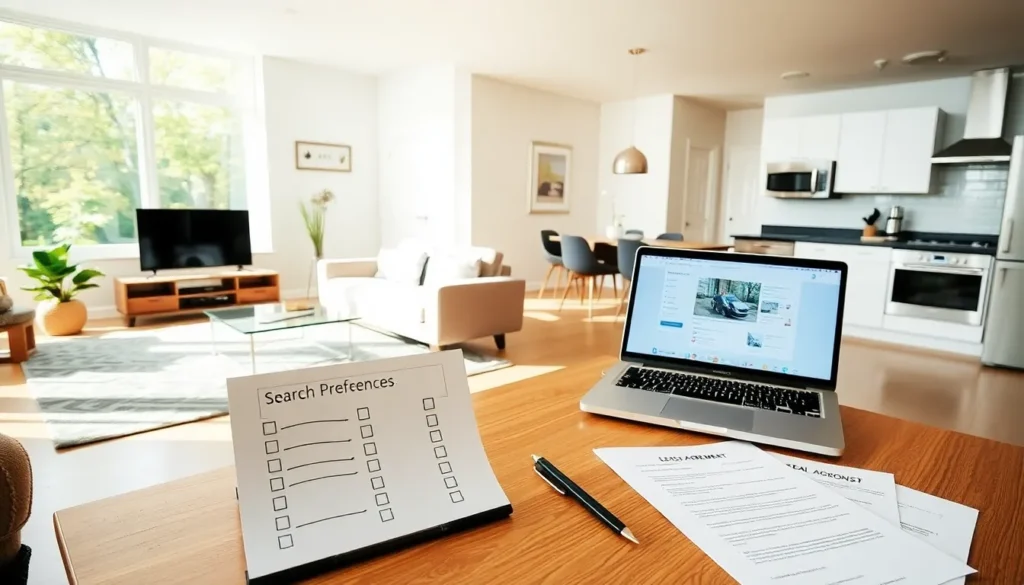Renting a house can feel like learning a new dance. You might not know which step to take first, but once you get the rhythm, it’s all about finding your groove. Whether you’re a first-timer or looking to brush up on your renting knowledge, this guide has you covered. Let’s break down the ins and outs of renting a house, because no one wants to get caught in a lease without knowing the beat.
Table of Contents
ToggleUnderstanding the Renting Process

Renting involves a series of well-defined steps that can sometimes be overwhelming. It all begins with figuring out personal preferences about location, size, and amenities of the house. From charming bungalows to modern townhouses, each option has its own appeal. Once these preferences are clear, the hunt begins. That’s like searching for a needle in a haystack, except the needle could be your dream home.
After narrowing it down, you’ll want to investigate into market research. Understanding the average rent prices in your desired area is crucial. This information acts as your compass in negotiations, ensuring you won’t overpay for what could be just another brick in the wall (rather than a cozy abode). Once you’ve settled on a place, it’s time to embark on the essential steps toward securing that coveted lease.
Finding A Rental Property
Finding a rental property can sometimes feel like dating: initially exciting but eventually complicated. The world of rentals offers various platforms to make this task easier.
Websites like Zillow, Craigslist, or local real estate agencies provide an extensive list of available properties. These platforms allow potential tenants to filter by price, size, and location. Visiting the neighborhoods in person also adds a flavorful touch to the search. While an online photo can captivate, nothing beats stepping inside to see if it feels like home.
Networking can be advantageous too. Friends or family might have insights into hidden gems not listed online. Word of mouth often leads to exciting opportunities. Once a few potential properties are identified, scheduling viewings is the next crucial step, and indeed, this is where excitement brews.
Signing The Lease Agreement
The lease agreement is a pivotal document that acts as a marriage certificate between you and your landlord, minus the cake, of course. This contract outlines all the expectations from both parties. Important points include the monthly rent, security deposit, duration of the lease, and any specific rules the landlord has put in place.
It’s vital to read the lease thoroughly before signing. Many tenants skip this step, unwittingly agreeing to terms that could lead to headaches down the road. Want a pet? Many leases include clauses about furry friends, and it’s crucial to know them before desperately searching for a pet-friendly property. If any questions arise, don’t hesitate to ask the landlord for clarification. After all, a well-informed tenant is a happy tenant.
Rent Payment Responsibilities
Once the lease is signed, the rhythm shifts to payments. Rent is due on a set schedule, usually monthly, and it’s important to stay on top of these payments to maintain a good relationship with the landlord. Many landlords provide multiple payment options: bank transfers, checks, or online platforms that allow for convenient transactions.
Understanding what happens if rent isn’t paid on time is also crucial. Late fees can add unnecessary stress, so knowing the grace period (if any) is vital. Keeping receipts or a record of payments is always a smart choice. In the digital age, it’s easier than ever to keep track of transactions, no more shoeboxes full of crumpled bills.
Rights And Responsibilities of Tenants
Being a tenant comes with rights and responsibilities, like being a superhero, minus the cape. Tenants have the right to a safe and habitable living environment free from harassment. This means landlords are obligated to handle repairs and respond to maintenance requests promptly.
On the flip side, tenants are responsible for treating the property with respect. This includes paying rent on time, keeping the place tidy, and adhering to lease guidelines. If a tenant jeopardizes these responsibilities, it could lead to eviction, a scenario everyone should strive to avoid. Understanding these rights and responsibilities helps ensure a harmonious living situation.
What To Expect During Your Tenancy
The tenancy period is usually a mixed bag of experiences. While most tenants find their rhythm, it’s important to anticipate challenges. From minor maintenance issues to communication with the landlord, staying proactive can turn potential headaches into smooth sailing.
Regular communication is key. If a light bulb goes out, a quick text to the landlord can save time and hassle in resolving issues. Consider documenting any concerns or repairs with photos. This evidence can come in handy if disputes arise later on.
Expect periodic inspections too. Landlords often want to ensure the property is being well cared for, leading to potential reminders about lease obligations or necessary maintenance requests.






